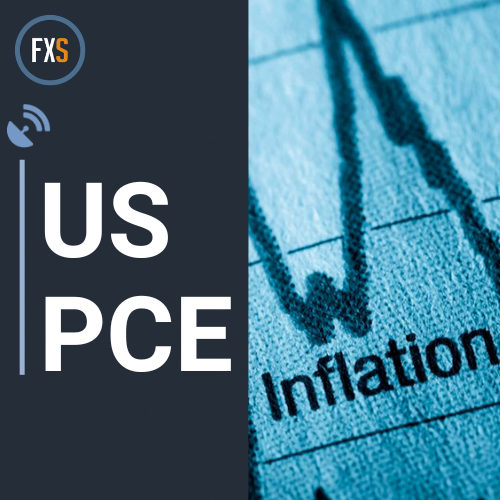US Core PCE Preview: Forecasts from nine major banks, a hot reading

The Fed’s preferred inflation gauge, the Core Personal Consumption Expenditure (PCE), will be released by the US Bureau of Economic Analysis (BEA) on Thursday, February 29 at 13:30 GMT and as we get closer to the release time, here are the forecasts of economists and researchers of nine major banks.
Core PCE price index is expected to have grown by 0.4% on a month-on-month basis in January against a 0.2% increase in December. If so, it would be the largest gain since last January. Annually, the underlying inflation data is forecast to have fallen a tick to 2.8%. Meanwhile, headline PCE is expected to fall two ticks to 2.4% YoY.
Commerzbank
We forecast a core rate of 0.4% MoM, i.e. an annualised rate of around 5%. This would be a significant setback for those expecting a rapid return of inflation to the Fed's 2% target. Some special effects may have played a role here, so a smaller increase is to be expected in February. However, January's data will reinforce our view that, on balance, inflation is falling only slowly and should eventually stabilise above the Fed's target.
ING
The core (ex-food & energy) personal consumer expenditure deflator is set to post a 0.4% MoM increase. We need to see MoM prints consistently below 0.2% MoM to be confident that inflation will return to the 2% YoY target over time, and we have been making excellent progress with six out of the past seven months seeing inflation come in sub 0.2%. However, the January PPI and CPI reports suggest that key components within the PCE deflator will post outsized increases this month with insurance, medical and portfolio management fees boosting inflation. Much of this isn’t especially driven by fundamental demand and supply factors – insurance is caused by higher crime relating to more expensive assets while strong equity market gains have boosted portfolio fees – but it presents a major stumbling block regarding the prospect of interest rate cuts. We are hopeful that February will post better numbers.
Deutsche Bank
We expect core PCE to show +0.36% MoM growth in January. This would make it the highest since last January. The fact that last January was 0.51% means that rolling out base effects should help the YoY rate edge down a tenth to 2.8%. However, it's the monthly print that will be all important.
TDS
Robust increases in Jan CPI/PPI data will likely result in a solid 0.36% MoM jump for the core PCE – its largest increase since 23Q1. The PCE's supercore likely also surged 0.55%, while we project the headline PCE to rise by a less solid 0.28% MoM. Firm inflation supports the Fed's desire to be patient before cutting rates.
NBF
The annual core PCE deflator may have progressed 0.4% MoM in January, a result which should translate into a one-tick decline of the 12-month rate to 2.8%. Although still above the Fed, this would still be the lowest rate observed in 34 months.
SocGen
The Fed may favour the PCE deflator over the CPI as an inflation measure, but confidence that inflation is moderating and can sustain the desired 2% pace will require all the inflation evidence to offer consistent views. The latest CPI for January shook confidence to the extent that CPI-core inflation was no longer converging upon the lower PCE inflation trend. It could be a one-month piece of noise. Unfortunately, we are expecting the PCE to be more elevated versus recent months as well. Not only were the CPI components that feed directly into the PCE up but healthcare costs and financial costs available in the PPI were also up. The risk may be on the core PCE, where we estimate a 0.4% MoM increase, but that is a rounded figure, and our estimate is closer to 0.36%. Rounding down versus rounding up could be the key to how markets react to the immediate release.
CIBC
We expect core PCE numbers to be a hot one with a 0.4% MoM reading based on the CPI and PPI data. Markets should not be too surprised with a hot core PCE reading given it’s the consensus view so we don’t expect much overreaction. Most Fed speakers have emphasized that cuts are not imminent and the pace of easing is going to be gradual.
Citi
Surprising strength in services prices across the board in both CPI and PPI data lead Cus to forecast similar strength in core PCE inflation in January, with a 0.38% MoM increase and the YoY reading moderating only slightly to 2.8%. This would also imply the 6-month annualized pace rises to 2.4% from 1.9%. Details of core PCE should also echo strength in services prices, with core services excluding shelter rising 0.55%, the strongest monthly pace since March 2022. On the other hand, goods prices should decline in core PCE, but less so than in core CPI.
Wells Fargo
We look for the headline deflator to slip to a year-ago rate of 2.4% and the core measure to fall further to 2.8%. However, the hot January CPI and PPI data suggest firmer monthly prints for both the headline and core (0.3% and 0.4%, respectively), driven by broad-based strength in services. We expect services less energy, food and housing to rise 0.6% in January, lifting the three-month annualized rate to 4.2%. Given services remain key to getting inflation on a sustained trajectory lower, it will likely prevent imminent rate cuts from the Fed.
Author

FXStreet Insights Team
FXStreet
The FXStreet Insights Team is a group of journalists that handpicks selected market observations published by renowned experts. The content includes notes by commercial as well as additional insights by internal and external analysts.

















